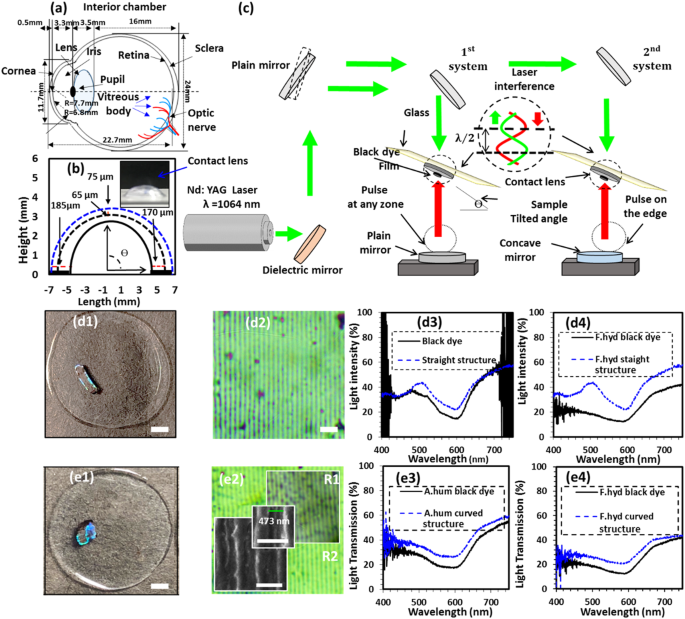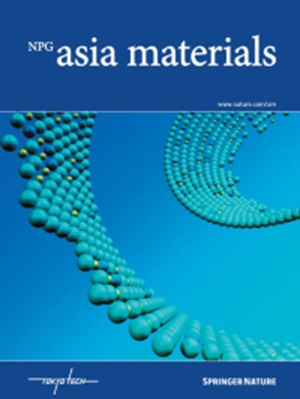通过可能适用于角膜接触镜产品的光学纳米结构监测眼部疾病
IF 8.3
2区 材料科学
Q1 MATERIALS SCIENCE, MULTIDISCIPLINARY
引用次数: 0
摘要
眼部疾病如果不及早发现,会导致视力问题甚至失明。有些眼病会使眼睛产生不规则的生理变化;因此,对眼睛进行持续监测的可靠诊断技术是临床尚未满足的需求。在这项研究中,使用脉冲激光(Nd:YAG)在基于水凝胶的商用隐形眼镜上创建光学纳米结构。通过模拟来确定纳米结构的间距,然后在环境湿度和完全水化的环境中产生纳米结构并在透镜上进行测试。随着环境的变化,纳米结构产生了4°的衍射角差异。在设计晶状体的纳米结构特征时,考虑了视觉障碍。在正常的室内光线下,弯曲的纳米结构呈现出一系列可见的彩虹色,平均范围为8°。我们还使用一个球面来模拟人眼,施加一个力(曲率变化)会导致纳米结构间距的改变,从而影响隐形眼镜的可见颜色。使用智能手机相机应用程序通过分析可见颜色的RGB颜色值来测量眼部疾病的进展。纳米结构对人工泪液中的K+离子变化也有响应,灵敏度为12 mmol L−1,这可能允许检测眼离子强度变化。脉冲激光在基于水凝胶的软性隐形眼镜上产生了光学纳米结构(全息图)。随着环境的变化,纳米结构产生了不同的衍射模式。在设计晶状体表面的纳米结构特征时,考虑了视觉障碍。隐形眼镜曲率的改变会引起纳米结构间距的改变,从而影响全息图的可见颜色。使用智能手机相机应用程序通过分析RGB颜色值来监测衍射颜色。本文章由计算机程序翻译,如有差异,请以英文原文为准。


Monitoring ocular disease via optical nanostructures potentially applicable to corneal contact lens products
Ocular diseases can cause vision problems or even blindness if they are not detected early. Some ocular diseases generate irregular physical changes in the eye; therefore, reliable diagnostic technology for continuous monitoring of the eye is an unmet clinical need. In this study, a pulsed laser (Nd:YAG) was used to create optical nanostructures on a hydrogel-based commercial contact lens. Simulations were used to determine the spacing of the nanostructures, which were then produced and tested on the lens in ambient humidity and fully hydrated environments. The nanostructures produced a 4° diffraction angle difference in response to the environmental changes. Vision obstruction was considered while designing the nanostructure features on the lens. The curved nanostructures exhibited a series of visible rainbow colors with an average range of 8° under normal room light. A spherical surface was also used to simulate the human eye, and application of a force (curvature change) caused the nanostructure spacing to change, influencing the visible color of the contact lenses. A smartphone camera application was used to measure the progress of ocular diseases by analyzing the RGB color values of the visible color. The nanostructures were also responsive to K+ ion variations in artificial tear fluids, with a 12 mmol L−1 sensitivity, which may allow the detection of ocular ionic strength changes. A pulsed laser created optical nanostructures (holograms) on hydrogel-based soft contact lenses. The nanostructures produced varying diffraction patterns in response to the environmental changes. Vision obstruction was considered while designing the nanostructure features on the lens surface. A change in curvature of the contact lens caused the nanostructure spacing to change, influencing the visible color of the hologram. A smartphone camera application was used to monitor the diffraction colors by analyzing the RGB color values.
求助全文
通过发布文献求助,成功后即可免费获取论文全文。
去求助
来源期刊

Npg Asia Materials
MATERIALS SCIENCE, MULTIDISCIPLINARY-
CiteScore
15.40
自引率
1.00%
发文量
87
审稿时长
2 months
期刊介绍:
NPG Asia Materials is an open access, international journal that publishes peer-reviewed review and primary research articles in the field of materials sciences. The journal has a global outlook and reach, with a base in the Asia-Pacific region to reflect the significant and growing output of materials research from this area. The target audience for NPG Asia Materials is scientists and researchers involved in materials research, covering a wide range of disciplines including physical and chemical sciences, biotechnology, and nanotechnology. The journal particularly welcomes high-quality articles from rapidly advancing areas that bridge the gap between materials science and engineering, as well as the classical disciplines of physics, chemistry, and biology. NPG Asia Materials is abstracted/indexed in Journal Citation Reports/Science Edition Web of Knowledge, Google Scholar, Chemical Abstract Services, Scopus, Ulrichsweb (ProQuest), and Scirus.
 求助内容:
求助内容: 应助结果提醒方式:
应助结果提醒方式:


